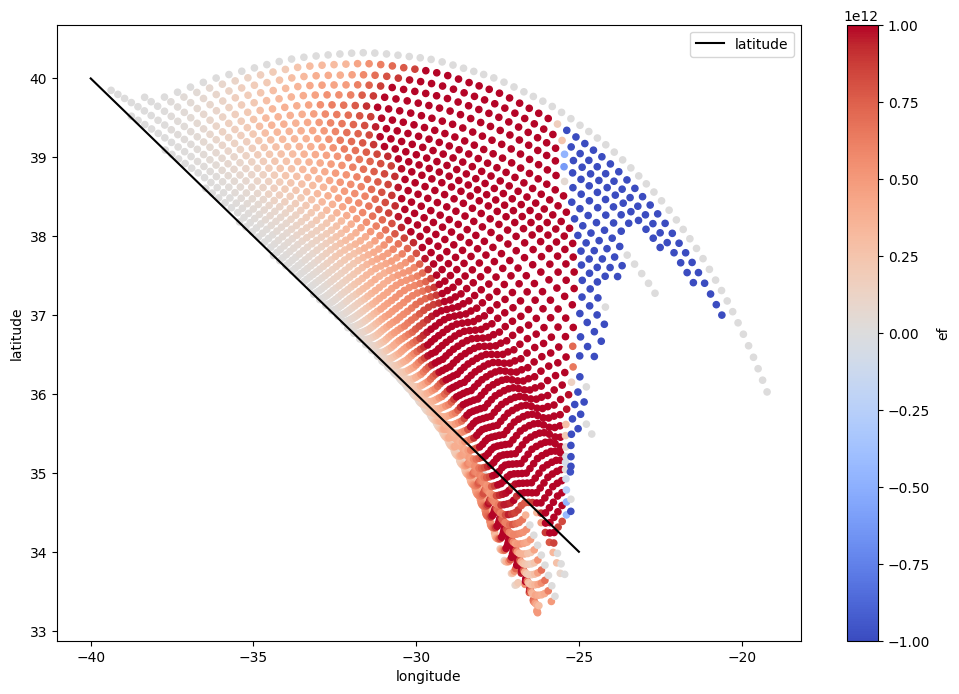Load GFS data¶
Requires
[gfs]optional dependencies:$ pip install pycontrails[gfs]
References¶
NOAA GFS - AWS Open Data Registry
See API Reference for usage.
[1]:
import numpy as np
from pycontrails.datalib.gfs import GFSForecast
[2]:
# get a single time
gfs = GFSForecast(
time="2022-03-01 01:00:00",
variables=["t", "q"], # Supports CF name or short names
pressure_levels=[200, 250, 300],
show_progress=True, # Shows download progress from AWS
)
gfs
[2]:
GFSForecast
Timesteps: ['2022-03-01 01']
Variables: ['t', 'q']
Pressure levels: [200, 250, 300]
Grid: 0.25
Forecast time: 2022-03-01 00:00:00
[3]:
# get a range of time
gfs = GFSForecast(
time=("2022-03-01 00:00:00", "2022-03-01 02:00:00"),
variables=[
"air_temperature",
"q",
], # supports CF name or short names
pressure_levels=[200, 250, 300],
show_progress=True,
)
gfs
[3]:
GFSForecast
Timesteps: ['2022-03-01 00', '2022-03-01 01', '2022-03-01 02']
Variables: ['t', 'q']
Pressure levels: [200, 250, 300]
Grid: 0.25
Forecast time: 2022-03-01 00:00:00
[4]:
# this triggers a download from AWS if file isn't in cache store
met = gfs.open_metdataset()
met
[4]:
MetDataset with data:
<xarray.Dataset>
Dimensions: (longitude: 1440, latitude: 721, level: 3, time: 3)
Coordinates:
* level (level) float64 200.0 250.0 300.0
* latitude (latitude) float64 -90.0 -89.75 -89.5 ... 89.5 89.75 90.0
* longitude (longitude) float64 -180.0 -179.8 -179.5 ... 179.5 179.8
forecast_time datetime64[ns] 2022-03-01
* time (time) datetime64[ns] 2022-03-01 ... 2022-03-01T02:00:00
air_pressure (level) float32 2e+04 2.5e+04 3e+04
altitude (level) float32 1.178e+04 1.036e+04 9.164e+03
Data variables:
air_temperature (longitude, latitude, level, time) float32 dask.array<chunksize=(1440, 721, 3, 1), meta=np.ndarray>
specific_humidity (longitude, latitude, level, time) float32 dask.array<chunksize=(1440, 721, 3, 1), meta=np.ndarray>
Attributes:
GRIB_edition: 2
GRIB_centre: kwbc
GRIB_centreDescription: US National Weather Service - NCEP
GRIB_subCentre: 0
Conventions: CF-1.7
institution: US National Weather Service - NCEP
history: 2023-07-12T15:51 GRIB to CDM+CF via cfgrib-0.9.1...
pycontrails_version: 0.49.3.dev50
provider: NCEP
dataset: GFS
product: forecast[5]:
# get steps for a specific forecast time
time_bounds = ("2022-11-18 16:00:00", "2022-11-18 18:00:00")
gfs = GFSForecast(
time_bounds,
variables=["t", "q"],
pressure_levels=[200, 250, 300, 350],
forecast_time=np.datetime64("2022-11-17 00:06:00"),
show_progress=True,
)
gfs
[5]:
GFSForecast
Timesteps: ['2022-11-18 16', '2022-11-18 17', '2022-11-18 18']
Variables: ['t', 'q']
Pressure levels: [200, 250, 300, 350]
Grid: 0.25
Forecast time: 2022-11-17 00:00:00
Run CoCiP with GFS¶
See the CoCiP Notebook for more details on running the CoCiP model.
[6]:
import numpy as np
import pandas as pd
from pycontrails import Flight
from pycontrails.models.cocip import Cocip
[7]:
time_bounds = ("2022-03-01 00:00:00", "2022-03-01 23:00:00")
pressure_levels = [300, 250, 200]
gfs_met = GFSForecast(
time_bounds, variables=Cocip.met_variables, pressure_levels=pressure_levels, show_progress=True
)
gfs_rad = GFSForecast(time_bounds, variables=Cocip.rad_variables, show_progress=True)
[8]:
# download data from AWS (or open from cache)
met = gfs_met.open_metdataset()
rad = gfs_rad.open_metdataset()
[9]:
# demo synthetic flight
flight_attrs = {
"flight_id": "test",
# set constants along flight path
"true_airspeed": 226.099920796651, # true airspeed, m/s
"thrust": 0.22, # thrust_setting
"nvpm_ei_n": 1.897462e15, # non-volatile emissions index
"aircraft_type": "E190",
"wingspan": 48, # m
"n_engine": 2,
}
# Example flight
df = pd.DataFrame()
df["longitude"] = np.linspace(-25, -40, 100)
df["latitude"] = np.linspace(34, 40, 100)
df["altitude"] = np.linspace(10900, 10900, 100)
df["engine_efficiency"] = np.linspace(0.34, 0.35, 100)
df["fuel_flow"] = np.linspace(2.1, 2.4, 100) # kg/s
df["aircraft_mass"] = np.linspace(154445, 154345, 100) # kg
df["time"] = pd.date_range("2022-03-01T00:15:00", "2022-03-01T02:30:00", periods=100)
flight = Flight(df, attrs=flight_attrs)
[10]:
# set up CoCiP model with GFS meteorology and radiation
params = {"dt_integration": np.timedelta64(10, "m")}
cocip = Cocip(met=met, rad=rad, params=params)
[11]:
# evaluate flight in CoCiP model
output_flight = cocip.eval(source=flight)
[12]:
# review the energy forcing from flight segments
ax = cocip.source.dataframe.plot("longitude", "latitude", color="k", figsize=(12, 8))
cocip.contrail.plot.scatter(
"longitude", "latitude", c="ef", cmap="coolwarm", vmin=-1e12, vmax=1e12, ax=ax
);
